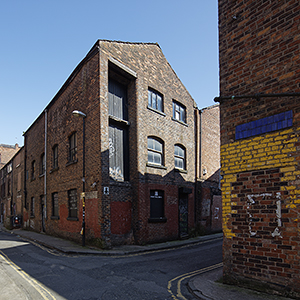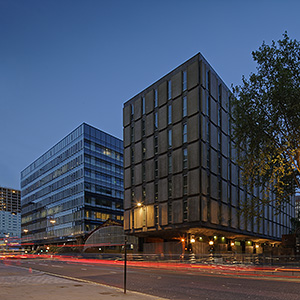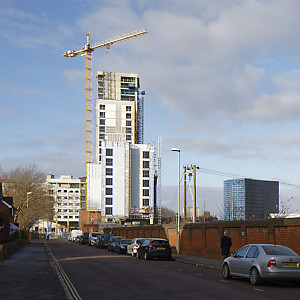Safety In Numbers
Please Note: The following is advice and does not ensure your safety. Just because you are in an affluent, low-crime area does not mean you are automatically safe. Please stay aware of your surroundings and if you feel worried or unsure of your safety, then leave. You can always come back with company or security another day. Your safety must come first.
Part of my job requires me to visit places that I have never been before. Some of these locations are low-risk areas with very low crime rates. However, when working in redevelopment areas the crime rates are usually higher than those found when photographing in fields in the middle of nowhere.
The problem is that you don't easily know how "bad" an area is before visiting it. Creating a metric for measuring how dangerous the area is has been difficult. What I now do is use the Neighbourhood Watch website https://www.ourwatch.org.uk to get a feel for the crime rates and the relative danger of working in that area, if that website isn't working you can try https://www.crime-statistics.co.uk/. In the past I have had a few close calls and know several people working in related disciplines who haven't been as lucky.
To use the Neighbourhood Watch website click on the following link which will open in a new window Crimes around Guildford (Ourwatch) or Crimes around Guildford (Crime-Statistics). Type in the postcode for the site and click Search, this will then calculate the number of Reported Crimes (RC) within one mile of the site. This gives us a standard area and allows us to make comparisons between different locations, in most cases it will also cover the majority of photographic viewpoints required for a site.
It's up to you to decide at what point you feel that the crime rate is above a safe level for what you are doing. My personal level for the job I do is 650. If there were more than 650 reported crimes per month, recently (last 3-6 months), within a mile of the site then I include the price of a security guard in the quote. If I was just passing through and grabbing the occasional shot with a camera phone, then I would blend into the background and may choose a higher number. For a Verified View image I need to set up a tripod, start taking Equipment out of my hi-vis rucksack and then have to wait for the shot and the light to be right, all of which makes me stand out from the crowd. The longer you are on site and the more visible you are, the higher the chance of trouble finding you, which is why I picked that number. I originally picked a place that I felt safe in and then looked up the number of Reported Crimes (RC), I compared this with other places I had worked and 650 seemed to be the point at which I was spending more time looking over my shoulder than through the camera. However this isn't the entire story. Reported crime isn't the only thing that may make you want to have security or company with you when you visit a site.
One of the lower scoring locations was Scunthorpe or more accurately the postcode DN17 1QY. However it is also the place that I had one of my closest calls. When you are out and about carrying a rucksack and a tripod you expect to draw some attention from curious locals, for want of a better description, the curtain twitchers. This is an expected part of the job and the worst that they usually do is call the police because "there's a strange guy taking photos of the mosque, motorway bridge or outside the school", all of which have happened. Then there are those who are actively watching, that make the hairs rise on the back of your neck, who just stand out because they aren't acting "normally". Scunthorpe was one of those.
I wasn't sure why things went the way they did, as it seemed to be a fairly "safe" area with a low reported crime rate until I looked a little deeper. If you plug the postcode into the following website 2019 English Index of Multiple Deprivation (IMD) map or Indices of Deprivation: 2019 and 2015. The data is generated from information gathered in 2019 from the 32,844 neighbourhoods in England. Most of the areas around DN17 1PS have a fairly average Deprivation Ranking (DR) but there is a band that falls into the top 10% of the most deprived neighbourhoods in England. DN17 1QY was in fact ranked 400/32,844 in 2015 which means only 1.2% of other English neighbourhoods are more deprived. The page above contains a control panel that allows you to enter a postcode. Below the postcode is an IMD Score slider (which is somewhat confusing). In the middle of the graduated slider is a row of dots, everything to the right of that row is in the "top 10%" of most deprived areas. If you change the left slider so that it reads 37.42 then only the most deprived areas will be marked on the map, the darker the area the more deprived. If you hover over the coloured neighbourhoods you can see information about that location and if it says "Decile 1" then it is in the top 10% of most deprived areas. Once again you need to work out at what point you feel that the area may not be safe. Personally if the area falls within the top 10% then my quote will include a charge for security. Using the colour-coded map allows you to easily check areas you may be passing through as you move between viewpoints.
The only practical problem once you have a map and a set of locations to visit is how do you find out the postcode for the viewpoint? You can use the post office find a postcode service. Or use UK Postcode Map, type in the postcode of the site and then move the map around until the crosshairs at the centre of the map are where you want to take the picture from. After a short search it generates the estimated postcode under the map.
After finding the postcode and checking the CR and Deprivation Level you now know if the area is above your comfort threshold. If it exceeds your threshold then the next question is "What type of security do you need?". From my experience there are two types of security available.
- Security Guards are there so that you aren't alone and your average solo ne'er-do-well will see you have company and probably find easier pickings elsewhere. In most cases they are the sort of security you see around shopping centres, court buildings and patrolling open-air markets. A body in a suit and a hi-vis jacket that means you aren't the easiest pickings. I wouldn't describe them as imposing.
- Close Protection or Close Personal Support is the industry term for bodyguards. I have only had to use their services a couple of times but was not disappointed with their attention to detail and presence. They are usually twice as expensive as security guards but when they are there it means I can fully focus on what I'm doing and leave them to do their job. When booking them I was after someone with a "Bouncer / Doorman" physique as the best confrontation is the one that doesn't happen, followed by the one that is professionally de-escalated. They were able to easily fulfill this "look" which is something that is uncommon for standard security guards.
In most cases security guards will do, however there are times when I need a higher level of protection. I use the following limits for when to have Close Protection, your values should reflect how safe you feel.
- Reported Crime is more than 4x the standard comfort level
- Reported Crime is more than 3x the standard comfort level and the Deprivation Level is in the bottom 10%
- Working after dark and either Reported Crime is more than 3x the standard comfort level or the Deprivation Level is in the bottom 10%
- Working after dark and both Reported Crime is more than 2x the standard comfort level or the Deprivation Level is in the bottom 20%
When booking security it's important that you are clear with the company supplying the security service what you expect, how you expect the security officer to behave and where they will be going. Security officers expect to arrive at a site and then stand around all day being bored and playing on their phone when nobody is looking. Doing a site visit and having to follow you around for miles while you take photographs and they have to watch the public to make sure that nobody has bad intentions is not their standard job and not what they expect to do in a normal day. Be kind and tell them to wear comfortable shoes if you are travelling over rough ground. When booking security I explain to the control room what we will be doing, the location and time we will start, the location and time we will finish. I am clear that this is an outside job not tied to a specific site and that we will be in public all day. When I meet the security guard I explain what I need them to do, watch the public, make sure nobody is acting strangely and that I get to go home at then end of the day with all of my equipment. You keep me safe by watching the public to see if anyone is paying too much attention to us. You can not do that well if you are looking at your phone.
Close Protection, it's what they do day in day out. Explain what you want and what you are doing, start and end locations and times. Then get on with your job and let them look out for you.
Here are some examples of values for various areas, the Reported Crimes (RC) and the Deprivation Rank (DR) the relevant dates are included in the column headings. The postcodes are for the train station at that location or centre of town if there is no station. The Deprivation Ranking starts with the most deprived neighbourhood at 1 and least deprived at 32,844.
Interested in learning more?
If you've looked through my site and have any questions, I'd be glad to help you. You can contact me on my mobile on 07801 103635 or send me an E-mail and I will get back to you as soon as I can.













